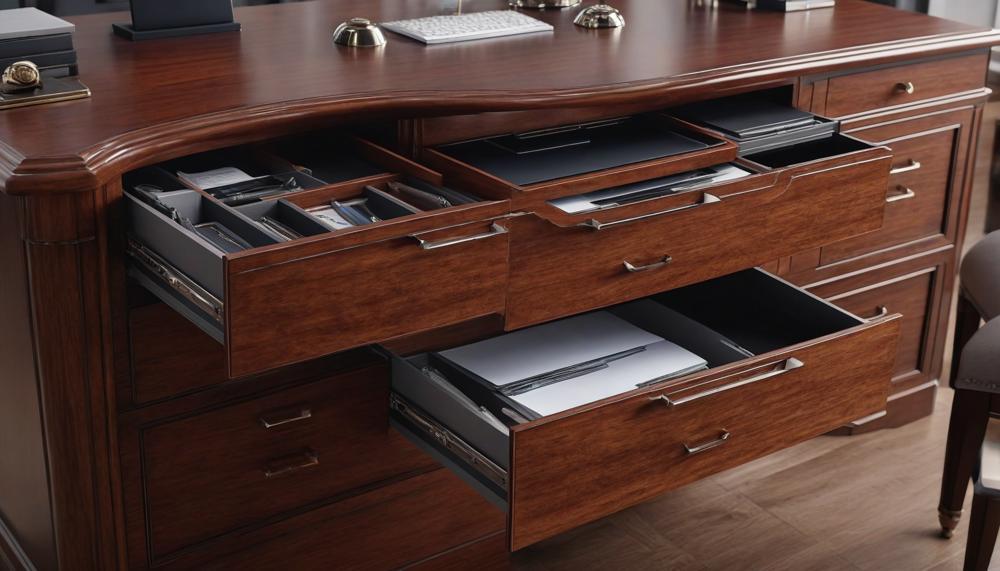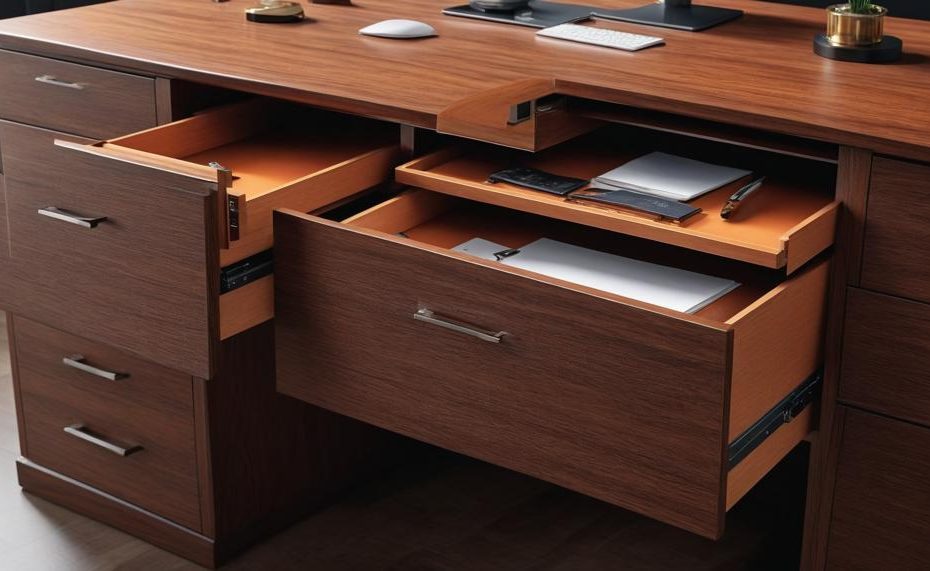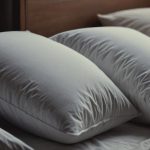Removing drawers from an executive desk can sometimes be more complex than it appears.
Whether you need to repair, replace, or simply clean them, knowing the correct method is essential for avoiding damage. This guide breaks down the steps to ensure a smooth removal process, tailored for various types of drawers you might encounter.
Key Takeaways:
- Top Drawer Technique: Slide the top drawer out as far as it will go, then gently tug and wiggle it free.
- Understanding Drawer Stops: Identify and release the stops that prevent drawers from being pulled out completely.
- Types of Mechanisms: Learn the difference between side-mounted, under-mounted, and center-mounted slides.
- Tools You Might Need: Keep a screwdriver and flashlight handy for hard-to-see or tight spaces.
- Safety Tips: Ensure the desk is stable and secure to avoid tipping or injury.
By following these straightforward steps, you can confidently and safely remove any drawer from your executive desk, making maintenance and adjustments a breeze.
Contents [show]
Metal Glides with Lever
The lever on metal glides serves a pivotal role in the efficient removal of drawers from an executive desk. This small yet essential component ensures a smooth, damage-free process by unlocking the glide mechanism that typically holds the drawer securely in place.
Purpose of the Lever:
- Facilitates Easy Removal: The lever acts as a release mechanism. By lifting or pressing the lever, you disengage the locking mechanism of the glide, allowing the drawer to be easily slid out.
- Prevents Damage: Without the lever, attempting to forcefully remove the drawer could damage the glide system or the drawer itself. The lever ensures a safe, controlled removal.
How It Helps in Removing Drawers:
- Identify the Lever: Locate the lever on the metal glide, usually found on the side of the drawer.
- Engage the Lever: Depending on the design, lift or press the lever. This action releases the drawer from its locked position within the glide.
- Slide Out the Drawer: With the lever engaged, gently slide the drawer out, maintaining a level motion to avoid tilting or angling, which could cause jamming or damage.
Wood Glides
Wood glides are traditional drawer slide mechanisms often found in vintage or antique furniture, such as dressers and armoires.
They consist of a wooden rail affixed to the interior sides of the drawer cavity and a corresponding groove or channel on the sides or bottom of the drawer itself. This simple yet effective design allows the drawer to slide in and out along the wooden rail.
How Wood Glides Assist in Removing Drawers
Removing drawers from an executive desk with wood glides is a straightforward process:
- Fully Extend the Drawer: Pull the drawer out as far as it will go. You may feel some resistance as the drawer nears the end of its track.
- Lift the Front of the Drawer: Once fully extended, lift the front of the drawer slightly. This action disengages the drawer from the wood glide track, allowing you to clear the stop mechanism often found in such setups.
- Slide the Drawer Out: After lifting, continue pulling the drawer out while maintaining the lifted position to clear any remaining obstacles.
Benefits and Considerations
| Aspect | Details | Notes |
| Simplicity | Wood glides offer a simple construction with minimal parts. | Easy to maintain and repair. |
| Durability | Wood glides are sturdy and can last for decades with proper care. | Regular lubrication (like candle wax) can reduce friction. |
| Vintage Appeal | Often found in older, high-quality furniture. | Adds a rustic charm to the furniture. |
While wood glides may not offer the silky smooth operation of modern metal gliders, they possess a charm and durability that many enthusiasts appreciate.
By understanding the simple mechanics of lifting and pulling, anyone can easily manage the removal of drawers with wood glides.
Anti-Tip Mechanisms
Anti-tip mechanisms are essential safety features in executive desks, designed to prevent accidents and injuries by maintaining the desk’s stability and structural integrity.
They are particularly crucial when drawers are extended, as this can cause the desk to tip over if not properly balanced.
| Mechanism Type | Description | Function |
| Counterweight System | Involves adding weight to the back of the desk, usually with steel plates. | Balances the desk by lowering the center of gravity, preventing tipping when drawers are pulled out. |
| Interlocking System | Connects drawers to each other or to the desk frame. | Ensures that opening one drawer pulls on the others or the frame, enhancing stability. |
| Wheel Locks | Locks the wheels of the desk in place. | Prevents the desk from moving when drawers are opened. |
| Adjustable Feet | Feet that can be adjusted for height. | Allows for leveling on uneven surfaces, keeping the desk stable. |
How Anti-Tip Mechanisms Prevent Accidents
- Stability Enhancement: The counterweight system lowers the desk’s center of gravity, making it more stable and less prone to tipping when drawers are extended.
- Drawer Interlock: The interlocking system ensures that when one drawer is opened, it secures the others, distributing the weight more evenly and preventing the desk from tipping.
- Movement Restriction: Wheel locks prevent the desk from rolling or shifting position when force is applied to a drawer, thus maintaining stability.
- Level Adjustment: Adjustable feet allow the desk to be leveled on uneven surfaces, preventing wobbling that could lead to tipping.
Benefits of Anti-Tip Mechanisms
- Prevents Desk Tipping: By balancing the weight and enhancing structural stability, anti-tip mechanisms reduce the risk of the desk tipping over when drawers are in use.
- Secures Drawers: These mechanisms prevent drawers from falling out, which can cause injuries or damage to the contents.
- Ensures Safety: Overall, anti-tip mechanisms ensure the safety of users by maintaining the desk’s stability during use.
Soft-Close Drawers
Soft-close drawers incorporate a mechanism with hydraulic dampers, which control the closing speed and ensure a gentle, noiseless closure.
When you push the drawer, the dampers engage, slowing the motion just before the drawer fully closes. This prevents slamming and reduces wear and tear.
Benefits of Soft-Close Drawers in an Executive Desk

| Feature | Benefit | Details |
| Noise Reduction | Quieter Environment | Eliminates the distracting noise of drawers slamming shut, creating a more peaceful workspace. |
| Durability | Extended Lifespan | Prevents the damage caused by constant slamming, ensuring the longevity of the desk and drawers. |
| Safety | Injury Prevention | Reduces the risk of pinched fingers or other injuries associated with drawers closing too quickly. |
| Organization | Improved Efficiency | Facilitates smoother operation, allowing for easy access and better organization of documents and office supplies. |
| Professional Aesthetic | Elegant Appearance | Soft-close mechanisms add a touch of sophistication and high-quality feel to any executive desk. |
Incorporating soft-close drawers into your executive desk enhances functionality and adds a layer of sophistication. Their practical benefits include maintaining a quieter workspace, prolonging the life of the furniture, and ensuring safety.
Stabilizer Screws
Stabilizer screws in executive desks serve a vital role in ensuring the structural integrity and functionality of the drawers, particularly when they are tasked with holding heavy items.
These screws help to maintain the alignment and balance of the drawers, preventing sagging or misalignment that could impede smooth operation.
Purpose of Stabilizer Screws
- Support and Stability: Stabilizer screws provide additional support to drawers, particularly those loaded with heavy contents. They keep the drawers aligned and prevent them from tipping or becoming misaligned over time.
- Enhanced Durability: By reinforcing the drawer structure, stabilizer screws extend the life of both the drawers and the desk itself. This is crucial for maintaining a high-quality appearance and functionality in an executive environment.
Impact on Drawer Removal
When it comes to removing drawers, stabilizer screws add an extra step but ensure the process is done safely and correctly:
- Starting Point: It is recommended to begin with the top drawer, which is more likely to contain stabilizer screws. Removing the top drawer first helps in maintaining balance and makes it easier to access the screws in lower drawers.
- Tool Requirements: Stabilizer screws are typically #8 size and require a specific screwdriver for removal. Using the right tool is essential to avoid stripping the screws and ensuring a smooth process.
- Order of Removal: Attempting to remove lower drawers before the top ones can lead to difficulties due to the stabilizer screws. These screws need to be accessed and removed in a sequential manner, starting from the top drawer downwards.
Remove Drawers With Full Extension Slide
To remove drawers with full extension slides from an executive desk, follow these detailed steps:
| Step | Description | Action |
| 1 | Identify Drawer Type | Determine if your drawer has a lever or tab mechanism. |
| 2 | Fully Extend Drawer | Pull the drawer out to its full extension. |
| 3 | Locate Release Mechanism | Find the levers or tabs on the slides. |
| 4 | Activate Release Mechanism | Push levers up or down, or press tabs/buttons. |
| 5 | Remove Drawer | Pull the drawer out completely. |
Conclusion
Removing drawers from an executive desk can seem complicated, but with the right techniques, it becomes straightforward. Whether you’re addressing repairs, replacements, or simply cleaning, understanding the correct method is crucial to avoid any damage.
For top drawers, the process often involves sliding them out as far as they go, then gently tugging and wiggling them free. Recognizing and releasing drawer stops is essential, as these prevent the drawers from being pulled out entirely. Knowing whether your desk uses side-mounted, under-mounted, or center-mounted slides can guide you in applying the correct removal technique.
Equipped with a screwdriver and a flashlight for those hard-to-reach spots, you can handle most drawer types. For metal glides with levers, the key is to locate the lever on the glide, engage it, and then smoothly slide the drawer out while maintaining a level motion.
Wood glides, often found in vintage furniture, require a simple lift and pull technique to disengage the drawer from its track. Anti-tip mechanisms, crucial for safety, ensure that your desk remains stable during drawer removal, preventing accidents.
Soft-close drawers add an element of sophistication and ease of use, while stabilizer screws maintain drawer alignment, especially when dealing with heavy loads.





